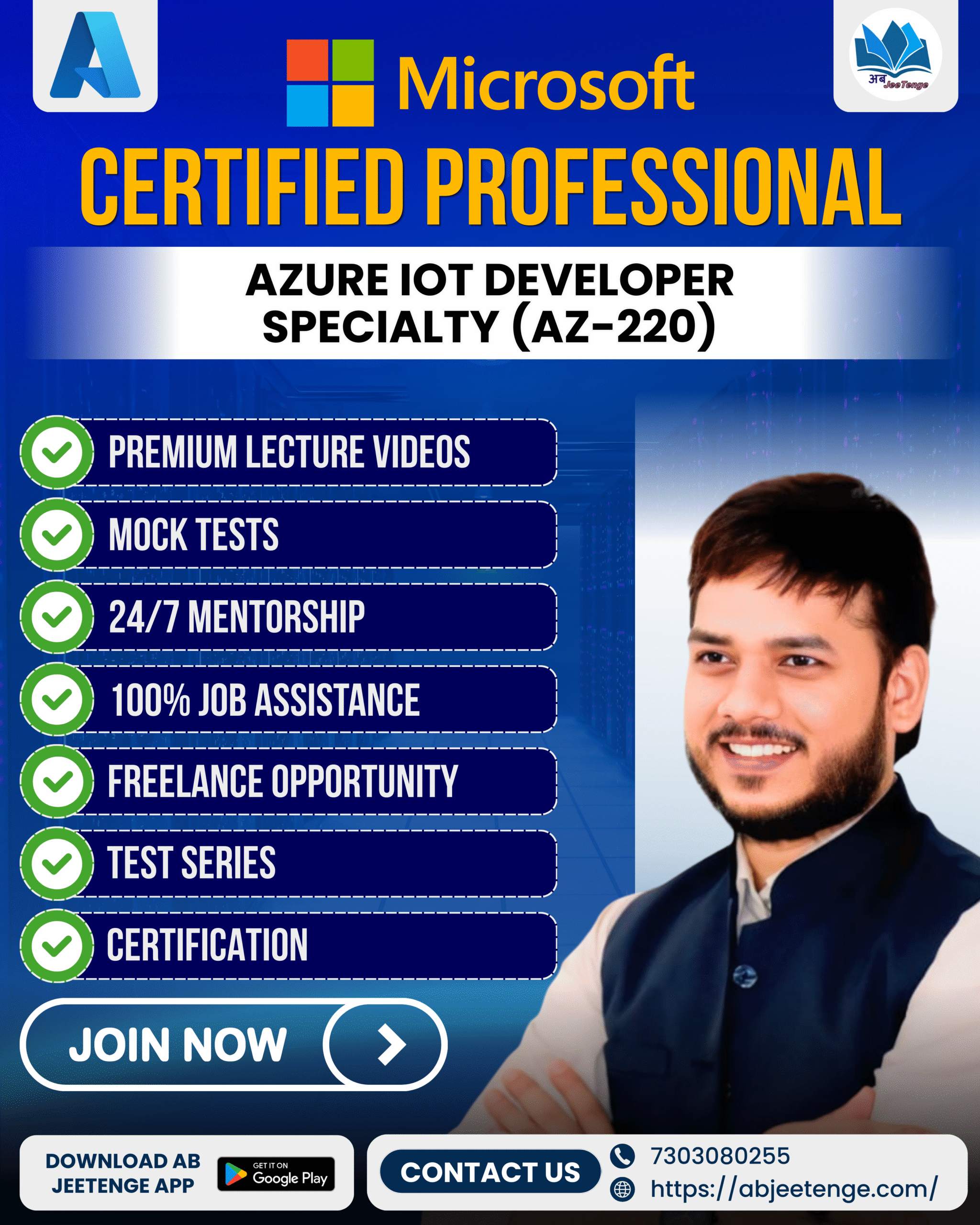Description
Questions: 168
Release Date: 07/2020 (Last Update: 04/2022)
Job Role: Developer
Language: English
The AZ-220 practice test contains 168 questions and covers the following objectives:
Set Up the IoT Solution Infrastructure – 18 questions
Create and configure an IoT Hub
- create an IoT Hub
- register a device
- configure a device twin
- configure IoT Hub tier and scaling
Build device messaging and communication
- build messaging solutions by using SDKs (device and service)
- implement device-to-cloud communication
- implement cloud-to-device communication
- configure file upload for devices
- optimize message size and scaling
- connect to IoT Hub using TLS server certificates
Configure physical IoT devices
- recommend an appropriate protocol based on device specifications
- configure device networking, topology, and connectivity
Provision and manage devices – 49 questions
Set up an IoT Hub Device Provisioning Service (DPS)
- create a DPS instance
- create a new enrollment in DPS
- link an IoT Hub to the DPS instance Manage the device lifecycle
- provision a device by using DPS
- deprovision an autoenrollment decommission (disenroll) a device
Manage IoT devices by using IoT Hub
- manage the devices list in the IoT Hub device registry
- modify device twin tags and properties
- configure a set of devices by using IoT Hub Automatic Device Management
- trigger an action on a set of devices by using IoT Hub Jobs and Direct Methods
- implement a device firmware update process by using device management primitives
- configure module identities
Manage IoT devices by using Azure IoT Central
- create a custom device template by using Azure IoT Central
- configure rules and actions in IoT Central
- customize the operator view
- add and manage devices from IoT Central
- troubleshoot device connections and data mapping
- create an application based on an app template for an industry vertical
- export a custom application template
- create and manage a new application based on a custom application template
- upgrade and version a device template
- run IoT Central jobs
- interact with IoT Central devices using the REST APIs
Implement IoT Edge – 30 questions
Set up an IoT Edge device
- create a device identity in IoT Hub
- set up an IoT device for IoT Edge
- select and install container runtime on IoT devices
- implement module access to the host system
- update IoT Edge runtime
- provision IoT Edge devices by using DPS
Deploy an IoT Edge device
- Plan and implement Conditional Access policies for connections to Azure Virtual Desktop
- Plan and implement multifactor authentication in Azure Virtual Desktop
- Manage security by using Azure Security Center
- Configure Microsoft Defender Antivirus for session hosts
Develop IoT Edge modules
- create and customize an IoT Edge module
- deploy a custom IoT Edge module to an IoT Edge device
- deploy an IoT Edge module from Azure Marketplace to an IoT Edge device
- publish an IoT Edge module to Azure Container Registry
- define module configuration
- configure IoT Edge module routing
- configure environment for IoT Edge development; debug IoT Edge modules in the development environment
Configure an IoT Edge device
- select an appropriate gateway pattern
- deploy an IoT gateway by using IoT Hub and IoT Edge
- configure IoT Edge certificates
- implement and configure offline support (including local storage)
- create a layered hierarchy of IoT Edge devices
Implement Business Integration – 9 questions
Integrate with upstream and downstream systems
- set up input and output connections
- set up IoT Hub routing for triggering workflows
- test data interface integration
- integrate third-party solutions
- configure workflows, including rules and alerts
Develop Azure Digital Twins solutions
- create Azure Digital Twins models and digital twins
- map IoT device data to Azure Digital Twins models and relationships
- ingest IoT device messages and translate messages to Azure Digital Twins
- configure routes and endpoints to trigger business logic and data processing
- query the Azure Digital Twins graph
- update properties on Azure Digital Twins entities in the graph
- monitor and troubleshoot Azure Digital Twins
Process and Manage Data – 25 questions
Configure message routing in Azure IoT Hub
- implement message enrichment in IoT Hub
- implement routing of IoT device messages to endpoints
- define and test routing queries
- configure IoT Hub as an Azure Event Grid source
- reconfigure the default Azure Event Hubs endpoint when there are multiple endpoints
Configure stream processing of IoT data
- create Azure Stream Analytics for data and stream processing of IoT data
- process and filter IoT data by using Azure Functions
- write user-defined functions and aggregations in Stream Analytics
- consume Azure Machine Learning functions in Stream Analytics
- configure Stream Analytics outputs
Create Azure Stream Analytics queries
- write a Stream Analytics query that runs in IoT Edge
- write a Stream Analytics query that runs in the cloud
Process real-time data by using Azure Time Series Insights
- create a Time Series Insights environment
- connect IoT Hub and the Time Series Insights environment
- create a reference data set for a Time Series Insights environment by using the Azure portal
- implement Time Series Model hierarchies, types, and instance fields
- consume data by using Time Series Expression syntax
Monitor, Troubleshoot, and Optimize IoT Solutions – 20 questions
Configure health monitoring
- configure metrics in IoT Hub
- set up diagnostics logs for IoT Hub
- configure IoT Hub scaling (SKU/unit) programmatically
- query and visualize tracing by using Azure Monitor
- apply Azure Policy definitions for IoT Hub
- gather IoT Edge metrics
- retrieve diagnostics from IoT Edge
Troubleshoot device communication
- establish maintenance communication by using RDP or SSH
- establish maintenance communication by using Azure Device Streams
- verify device telemetry is received by IoT Hub
- validate device twin properties, tags, and direct methods
- troubleshoot device disconnects and connects
- troubleshoot IoT Edge devices
Ensure performance and availability
- identify and resolve bottlenecks
- calculate capacity requirements for each service
- troubleshoot message loss
- test manual failover
Implement Security – 17 questions
Implement security for IoT devices and services
- implement device and gateway security
- ensure secure connections Implement Azure Defender for IoT
- configure an Azure Defender for an IoT agent-based solution
- implement Defender-IoT-micro-agents (security agents)
- configure built-in and custom alerts for IoT Hub
Notes:
- The bullets that follow each of the skills measured are intended to illustrate how we are assessing that skill. Related topics may be covered in the exam.
- Most questions cover features that are general availability (GA). The exam may contain questions on Preview features if those features are commonly used.






Reviews
There are no reviews yet.